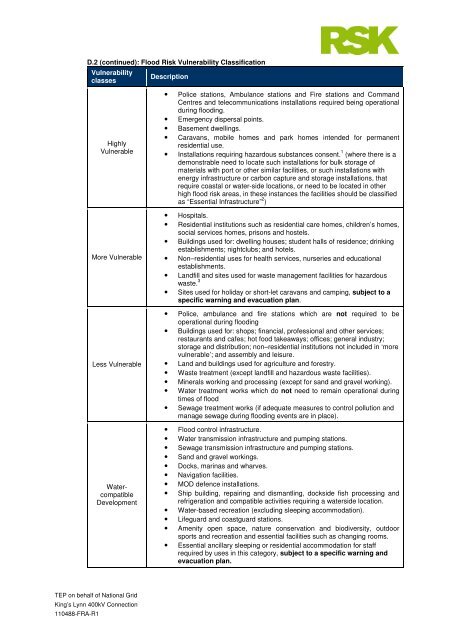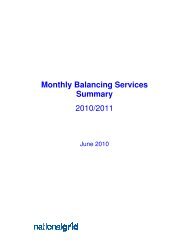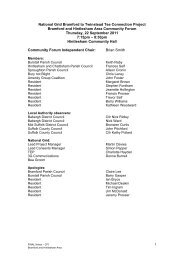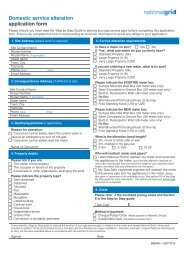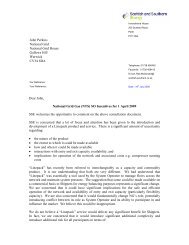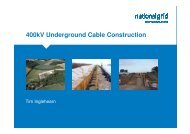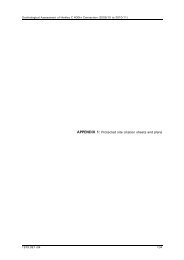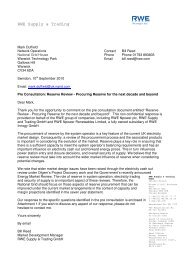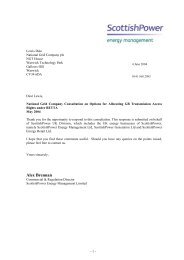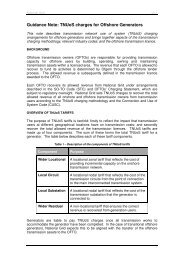appendix a - National Grid
appendix a - National Grid
appendix a - National Grid
You also want an ePaper? Increase the reach of your titles
YUMPU automatically turns print PDFs into web optimized ePapers that Google loves.
TEP on behalf of <strong>National</strong> <strong>Grid</strong><br />
King’s Lynn 400kV Connection<br />
110488-FRA-R1<br />
D.2 (continued): Flood Risk Vulnerability Classification<br />
Vulnerability<br />
classes<br />
Highly<br />
Vulnerable<br />
More Vulnerable<br />
Less Vulnerable<br />
Watercompatible<br />
Development<br />
Description<br />
• Police stations, Ambulance stations and Fire stations and Command<br />
Centres and telecommunications installations required being operational<br />
during flooding.<br />
• Emergency dispersal points.<br />
• Basement dwellings.<br />
• Caravans, mobile homes and park homes intended for permanent<br />
residential use.<br />
• Installations requiring hazardous substances consent. 1 (where there is a<br />
demonstrable need to locate such installations for bulk storage of<br />
materials with port or other similar facilities, or such installations with<br />
energy infrastructure or carbon capture and storage installations, that<br />
require coastal or water-side locations, or need to be located in other<br />
high flood risk areas, in these instances the facilities should be classified<br />
as “Essential Infrastructure” 2 )<br />
• Hospitals.<br />
• Residential institutions such as residential care homes, children’s homes,<br />
social services homes, prisons and hostels.<br />
• Buildings used for: dwelling houses; student halls of residence; drinking<br />
establishments; nightclubs; and hotels.<br />
• Non–residential uses for health services, nurseries and educational<br />
establishments.<br />
• Landfill and sites used for waste management facilities for hazardous<br />
waste. 3<br />
• Sites used for holiday or short-let caravans and camping, subject to a<br />
specific warning and evacuation plan.<br />
• Police, ambulance and fire stations which are not required to be<br />
operational during flooding<br />
• Buildings used for: shops; financial, professional and other services;<br />
restaurants and cafes; hot food takeaways; offices; general industry;<br />
storage and distribution; non–residential institutions not included in ‘more<br />
vulnerable’; and assembly and leisure.<br />
• Land and buildings used for agriculture and forestry.<br />
• Waste treatment (except landfill and hazardous waste facilities).<br />
• Minerals working and processing (except for sand and gravel working).<br />
• Water treatment works which do not need to remain operational during<br />
times of flood<br />
• Sewage treatment works (if adequate measures to control pollution and<br />
manage sewage during flooding events are in place).<br />
• Flood control infrastructure.<br />
• Water transmission infrastructure and pumping stations.<br />
• Sewage transmission infrastructure and pumping stations.<br />
• Sand and gravel workings.<br />
• Docks, marinas and wharves.<br />
• Navigation facilities.<br />
• MOD defence installations.<br />
• Ship building, repairing and dismantling, dockside fish processing and<br />
refrigeration and compatible activities requiring a waterside location.<br />
• Water-based recreation (excluding sleeping accommodation).<br />
• Lifeguard and coastguard stations.<br />
• Amenity open space, nature conservation and biodiversity, outdoor<br />
sports and recreation and essential facilities such as changing rooms.<br />
• Essential ancillary sleeping or residential accommodation for staff<br />
required by uses in this category, subject to a specific warning and<br />
evacuation plan.


